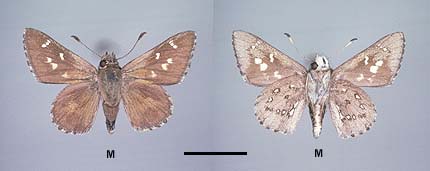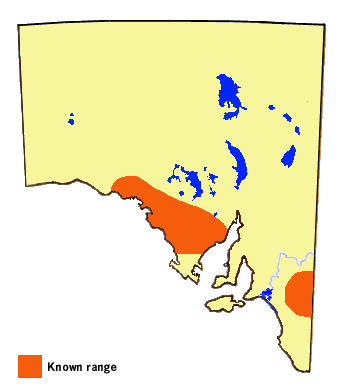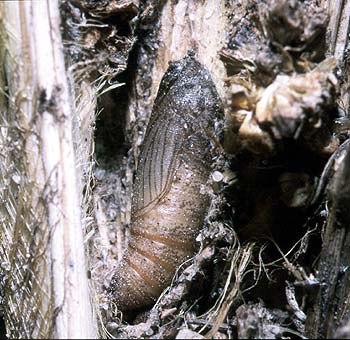Sciron Rush-skipper
Trapezites sciron eremicola (Burns)
Interesting Aspects

Probably the most drab butterfly to be found in South Australia.
Trapezites sciron eremicola (Burns)

Probably the most drab butterfly to be found in South Australia.
Lomandra collina (pale mat-rush or iron grass) (Asparagaceae). The larvae feed on the leaves of the hostplant, which is usually a most unappetising tussock-like small plant with flattened wiry leaves as hard as 'iron'.
Small, initially pale yellow coloured, later marked red if fertile, hemi-spherical (domal) with strong vertical ribs numbering 17-19, laid singly on the hostplant. Eggs are usually laid on hostplant situated in full sun.
Mature final instar is 20-25 mm long.
Brown with darker markings, 16-18 mm long, short and fat, with minimal ornamentation about the head, abdomen bristly, and the cremaster is very long and spinose. Pupation takes place during late winter or early spring, usually within the final larval shelter.
Mid September to late November. Only one brood a year.

Presently known from Eyre Peninsula, and the Upper Southeast and adjoining southern areas of the Murray Mallee. The distribution may be more extensive than presently known, and until 20 years ago only a handful of specimens were known from South Australia. The local subspecies of the skipper is also found in western Victoria. Another subspecies occurs in south-west Western Australia.

The skipper occurs in mallee areas (dry Eucalyptus woodland) wherever its hostplant occurs in sufficient density. It has a preference for its hostplant growing in sand dunes, and likes its hostplant to be in full sun and uncongested by other plants. The skipper, particularly the males, has a strong preference for dune-tops, and the presence of dunes is probably a habitat pre-requisite. The early stages of the skipper may also require dry conditions, as the hostplant is very common in habitat having calcareous soils, including habitat occurring in higher rainfall areas, yet the skipper is only found in the dry areas.
Usually rare, but can be locally common after a good season.
Known colonies occur within broad acre remnants of suitable mallee habitat, particularly within the larger conservation parks. It therefore seems the skipper is highly susceptible to the effects of urbanisation and agricultural activity. Large bushfires within its habitat would be the major threat.
The main strategy would be to retain large blocks of mallee vegetation containing suitable habitat for the skipper. Consideration should be given to the introduction of the skipper into the remaining large conserved areas of mallee habitat if the skipper is not already present in those areas.
